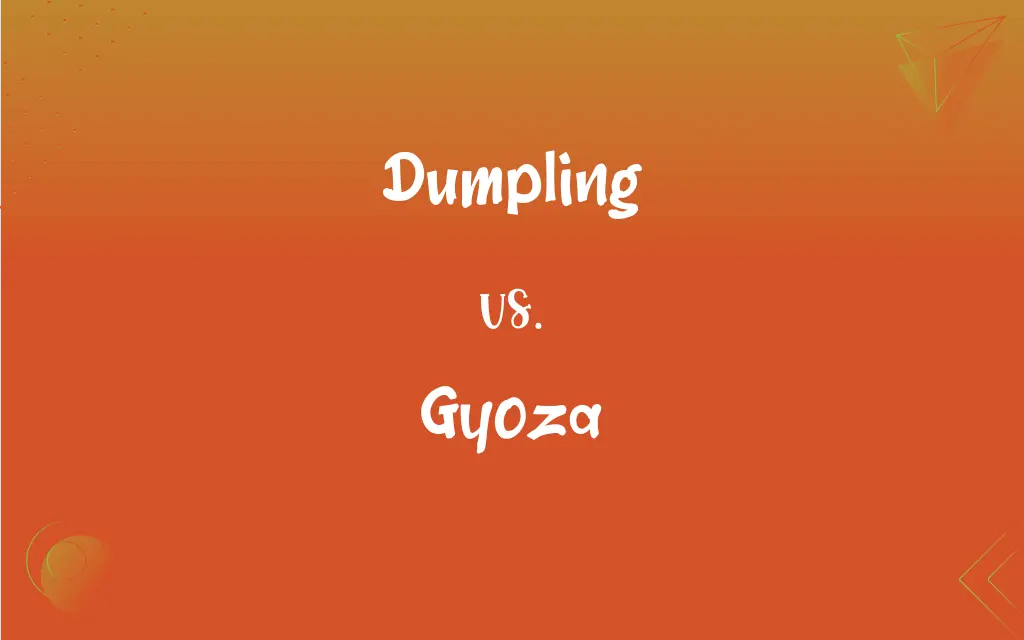Dumpling vs. Gyoza: What's the Difference?
By Harlon Moss & Aimie Carlson || Updated on May 23, 2024
A dumpling is a broad term for dough-wrapped fillings cooked by boiling, steaming, or frying, while gyoza is a specific type of Japanese dumpling known for its thin wrapper and pan-fried preparation.

Key Differences
Dumplings are a versatile food found in many global cuisines, consisting of dough wrapped around various fillings. They can be prepared in several ways, including boiling, steaming, or frying. Dumplings can be savory or sweet, with fillings ranging from meat and vegetables to fruits and sweets. Gyoza, on the other hand, are a specific type of Japanese dumpling influenced by Chinese jiaozi. They are typically filled with ground meat, cabbage, and garlic, and are known for their thin wrappers and distinctive cooking method, which involves pan-frying to achieve a crispy bottom and then steaming to cook the filling thoroughly.
Dumplings vary widely across cultures, including Chinese wontons, Italian ravioli, and Polish pierogi. Each type has unique fillings and cooking methods, reflecting regional tastes and traditions. Gyoza, while similar to Chinese dumplings, have a unique flavor profile and texture due to the use of ingredients like garlic and ginger and the pan-frying method that gives them a crispy texture on one side.
Dumplings can be found in soups, as standalone dishes, or as part of larger meals, adapting to the culinary context of their region. Gyoza are often served as appetizers or side dishes in Japanese cuisine, commonly accompanied by dipping sauces like soy sauce with vinegar and chili oil. They are a popular item in Japanese restaurants worldwide, often enjoyed with ramen or other Japanese dishes.
Dumplings’ preparation methods include boiling in water or broth, steaming in a bamboo steamer, or deep-frying in oil, offering a variety of textures. Gyoza are distinctive for their specific cooking technique that combines frying and steaming in the same pan, resulting in a dumpling that is both crispy and tender.
Comparison Chart
Definition
Broad term for dough-wrapped fillings
Specific type of Japanese dumpling
ADVERTISEMENT
Origin
Various global cuisines
Japan, influenced by Chinese jiaozi
Wrapper Thickness
Varies, often thicker
Thin wrapper
Cooking Methods
Boiling, steaming, frying
Pan-frying then steaming
Typical Fillings
Meat, vegetables, fruits, sweets
Ground meat, cabbage, garlic
Dumpling and Gyoza Definitions
Dumpling
A versatile food in many cuisines.
She enjoyed dumplings in her soup.
ADVERTISEMENT
Gyoza
Pan-fried then steamed for texture.
Gyoza are pan-fried to crisp the bottom before steaming.
Dumpling
Dough wrapped around a filling.
The dumpling was filled with minced pork and vegetables.
Gyoza
Typically filled with ground meat and cabbage.
She made pork gyoza with garlic and ginger.
Dumpling
Can be sweet or savory.
The apple dumpling was served with ice cream.
Gyoza
Japanese dumplings with thin wrappers.
The restaurant's gyoza were perfectly crispy.
Dumpling
A piece of dough, sometimes filled, that is cooked in liquid such as water or soup.
Gyoza
Influenced by Chinese jiaozi.
Gyoza are similar to Chinese potstickers but have a distinct flavor.
Dumpling
Sweetened dough wrapped around fruit, such as an apple, baked and served as a dessert.
Gyoza
Served with dipping sauces.
He dipped the gyoza in soy sauce with vinegar.
Dumpling
(Informal) A short, chubby creature.
Gyoza
A pocket of dough that is stuffed, as with minced pork or shrimp, and fried, steamed, or boiled.
Dumpling
(culinary) A ball of dough that is cooked and may have a filling and/or additional ingredients in the dough.
Gyoza
A Japanese crescent-shaped dumpling filled with a minced stuffing and steamed, boiled or fried; the Japanese equivalent of the Chinese jiaozi.
Dumpling
By restriction, a food composed of a dough wrapper around a filling.
Dumpling
(endearing) A term of endearment.
My little dumpling.
Dumpling
A piece of excrement.
Dumpling
A roundish mass of dough boiled in soup, or as a sort of pudding; often, a cover of paste inclosing an apple or other fruit, and boiled or baked; as, an apple dumpling.
Dumpling
Small balls or strips of boiled or steamed dough
Dumpling
Dessert made by baking fruit wrapped in pastry
Dumpling
A small mass of dough cooked by boiling or steaming.
Chicken and dumplings is a comforting dish.
Dumpling
Cooked by various methods like boiling, steaming, or frying.
Fried dumplings are crispy and delicious.
FAQs
Are dumplings always savory?
No, dumplings can be sweet or savory.
How are dumplings cooked?
Dumplings can be boiled, steamed, or fried.
What is a dumpling?
A dumpling is a broad term for dough-wrapped fillings, cooked by boiling, steaming, or frying.
What are common fillings for gyoza?
Common fillings include ground meat, cabbage, garlic, and ginger.
Are dumplings found in many cultures?
Yes, dumplings are a staple in many global cuisines.
What is a common accompaniment for gyoza?
Gyoza are often served with ramen or other Japanese dishes.
What makes gyoza different from other dumplings?
Gyoza have a thin wrapper and are typically pan-fried then steamed, giving them a unique crispy and tender texture.
What dipping sauces are served with gyoza?
Gyoza are often served with soy sauce mixed with vinegar and chili oil.
Can dumplings be sweet?
Yes, dumplings can be sweet, filled with fruits or sweetened ingredients.
Where do gyoza originate from?
Gyoza originate from Japan, influenced by Chinese jiaozi.
Can dumplings be deep-fried?
Yes, some dumplings are deep-fried for a crispy texture.
Are dumplings a main dish or side dish?
Dumplings can be served as either a main dish or a side dish.
Can dumplings be part of soups?
Yes, dumplings can be included in soups.
Are gyoza wrappers thick or thin?
Gyoza wrappers are thin.
Do all dumplings look the same?
No, dumplings come in various shapes and sizes depending on their cultural origin.
Can gyoza be boiled?
Gyoza are typically pan-fried and steamed, but they can also be boiled, though this is less common.
Do gyoza have a specific shape?
Gyoza are typically crescent-shaped.
How are gyoza typically cooked?
Gyoza are pan-fried first to crisp the bottom and then steamed to cook the filling.
What ingredients give gyoza their flavor?
Garlic, ginger, and cabbage are key ingredients in gyoza filling.
Is gyoza a common dish in Japanese restaurants?
Yes, gyoza are a popular item in Japanese restaurants worldwide.
About Author
Written by
Harlon MossHarlon is a seasoned quality moderator and accomplished content writer for Difference Wiki. An alumnus of the prestigious University of California, he earned his degree in Computer Science. Leveraging his academic background, Harlon brings a meticulous and informed perspective to his work, ensuring content accuracy and excellence.
Co-written by
Aimie CarlsonAimie Carlson, holding a master's degree in English literature, is a fervent English language enthusiast. She lends her writing talents to Difference Wiki, a prominent website that specializes in comparisons, offering readers insightful analyses that both captivate and inform.
































































